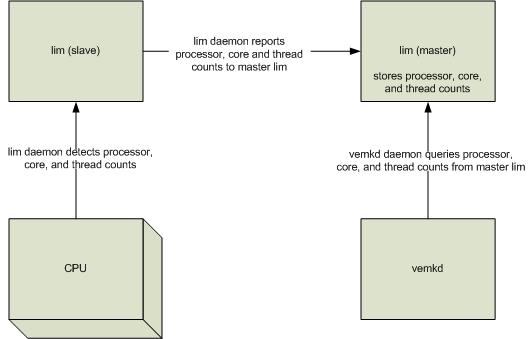How LIM detects cores, threads, and processors
The number of processors
Cores—the number of cores (per processor) * the number of processors (this is the ncpus default setting)
Threads—the number of threads (per core) * the number of cores (per processor) * the number of processors
A cluster administrator globally defines how ncpus is computed using the EGO_DEFINE_NCPUS parameter in lsf.conf or ego.conf (instead of LSF_ENABLE_DUALCORE in lsf.conf, or EGO_ENABLE_DUALCORE in ego.conf).

Although the ncpus computation is applied globally, it can be overridden on a per-host basis.
To correctly detect processors, cores, and threads, LIM assumes that all physical processors on a single machine are of the same type.
In cases where CPU architectures and operating system combinations may not support accurate processor, core, thread detection, LIM uses the defaults of 1 processor, 1 core per physical processor, and 1 thread per core. If LIM detects that it is running in a virtual environment (for example, VMware®), each detected processor is similarly reported (as a single-core, single-threaded, physical processor).
LIM only detects hardware that is recognized by the operating system. LIM detection uses processor- or OS-specific techniques (for example, the Intel CPUID instruction, or Solaris kstat()/core_id). If the operating system does not recognize a CPU or core (for example, if an older OS does not recognize a quad-core processor and instead detects it as dual-core), then LIM does not recognize it either.
RQL normalization never considers threads. Consider a hyper-thread enabled Pentium: Threads are not full-fledged CPUs, so considering them as CPUs would artificially lower the system load.
ncpus detection on AIX
On a machine running AIX, detection of ncpus is different. Under AIX, the number of detected physical processors is always 1, whereas the number of detected cores is always the number of cores across all physical processors. Thread detection is the same as other operating systems (the number of threads per core).